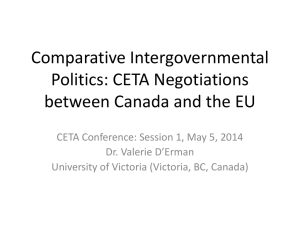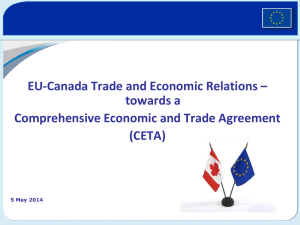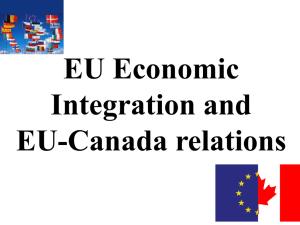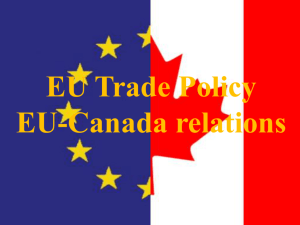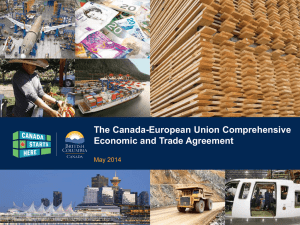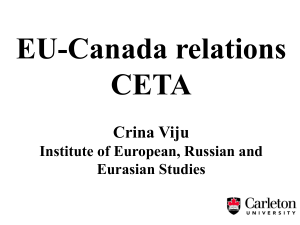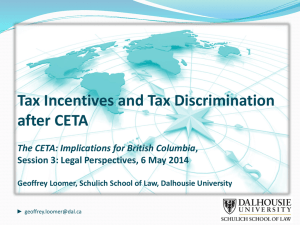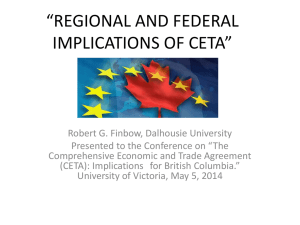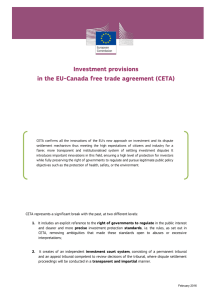CETA and Financial Services
advertisement
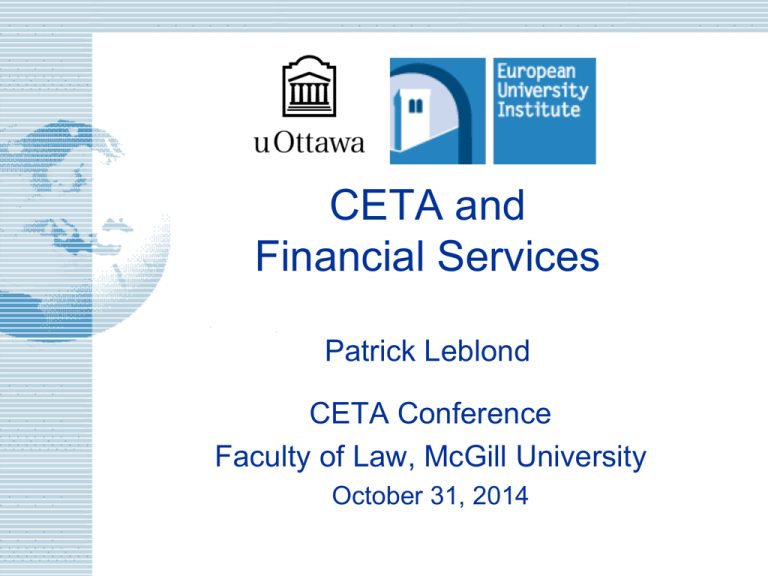
CETA and Financial Services Patrick Leblond CETA Conference Faculty of Law, McGill University October 31, 2014 Introduction • CETA contains a whole chapter devoted to financial services • It was apparently one of the last parts of the agreement to be settled – Prudential carve-out was the issue • The provisions are mostly aligned with the GATS and NAFTA – But a bit different for prudential carve-out © Patrick Leblond – CETA Conference 2014 2 Financial Services in CETA • Cross-border trade in financial services – National treatment – MFN treatment – Market access • • • • • • Effective and transparent regulation Access to payment and clearing systems Prudential carve-out Financial Services Committee Dispute settlement ISDS © Patrick Leblond – CETA Conference 2014 3 What does it mean? • Cross-border selling of financial services in the other party’s jurisdiction (mode 1) – E.g., loans, deposits, insurance • Travel to the other party’s jurisdiction to obtain financial services (mode 2) – E.g., financial advice • Set up operations in the other party’s jurisdiction (e.g., branch, subsidiary) (mode 3) • Cross-border movement of natural persons as financial service suppliers (mode 4) © Patrick Leblond – CETA Conference 2014 4 Implications for selling financial services in Canada • Wide ownership remains – No one shareholder can own more than 20% of outstanding voting shares (30% non-voting) if equity is more than $12 billion • An acquisition of 10% or more of assets needs the approval of the finance minister if equity is $2 billion or more • If equity is less than $12 billion, then shareholding can be higher – No longer tied to foreign ownership (since 1995 as a result of GATS) • Branches by foreign entities are limited to deposits of $150,000 or more © Patrick Leblond – CETA Conference 2014 5 Prudential Carve-out (1) • The issue: can prudential regulation be weakened because of ISDS? – Financial institutions can challenge the “fair and equitable treatment” by the financial regulator • What will be the meaning of “reasonable measures for prudential reasons” (Article 15.1 of the FS chapter)? – How useful are the “high-level principles” in the in the Annex providing “guidance” on Article 15.1 (an innovation)? • If regulation is in line with international standards under the FSB, then it should be okay © Patrick Leblond – CETA Conference 2014 6 Prudential Carve-out (2) • Financial Services Committee to act as a “filter mechanism” – Respondent “may” refer to the FSC – If the FSC decides that the prudential carve-out (PCO) applies, then that’s the end of the process – If the PCO does not apply or only in part, then it proceeds to the tribunal – If no agreement at the FSC, then it goes to the Trade Committee before going to the tribunal • Alleged compromise: the EU originally wanted the traditional approach (i.e. leave it to the independent tribunal) while Canada wanted only FSC to decide © Patrick Leblond – CETA Conference 2014 7 TTIP and Financial Services • Both sides want greater market access but they disagree on regulatory cooperation: at the international level or within TTIP? – EU wants to protect the position of European banks in the US • Threatened to remove financial services altogether – US is not interested in harmonization • No regulatory cooperation in CETA – But the stakes are not as high! © Patrick Leblond – CETA Conference 2014 8 Conclusions • How will CETA affect the financial services sector in Canada and the EU? – Impact will probably be marginal – Barriers to trade and market access are not high to begin with because of commitments under the GATS • In Canada, lack of internal free trade for some financial services represents an obstacle for EU suppliers – E.g., insurance, securities brokerage, personal financial advice © Patrick Leblond – CETA Conference 2014 9 THANK YOU! © Patrick Leblond – CETA Conference 2014 10
